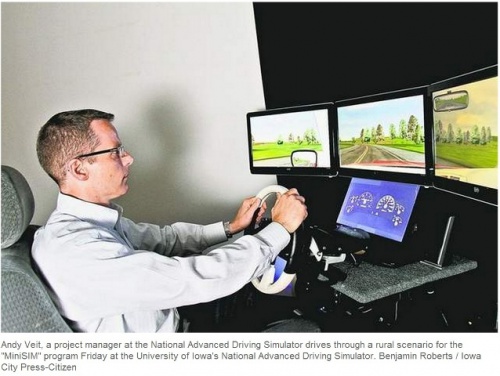NEWS: Driving Simulator Aims to Reduce Fatality Rates
Publish Date: Jul 26, 2011
Iowa City Press-Citizen
Source: Iowa City Press-Citizen: Driving Simulator Aims to Reduce Fatality Rates
After his son was killed in a car crash nine years ago, Murdoch Morrison became passionate about helping train young drivers, studying driver training programs and researching accident statistics.
Now he has partnered with the National Advanced Driving Simulator at the University of Iowa and the company DrivingMBA to develop a training simulation program he hopes eventually will help prepare new drivers across the country. "Ninety-one people are killed every day on our highways," Morrison said. "The fatality rate has come down over the last five to seven years, but it's still way too high. I have been determined for some years to figure out how to bring a better solution to the plate."
For Morrison, that solution is the DrivingMBA program offered in the Phoenix area that uses simulators to help students experience dangerous or uncommon scenarios in a less risky environment. They also receive intense one-on-one instruction with trainers, Morrison said.
So far, it's been successful, he said. According to Morrison, nearly 50 percent of all new drivers have an incident during their first year. Those range from everything from running into the mailbox to a severe collision, he said.
But for the more than 5,500 who have received DrivingMBA training, the first-year incident rate was less than 12 percent, Morrison said.
So he reached out to the owners of Driving MBA about the option of expanding the program and helped establish DrivingMBA Global.
Then Morrison reached out to the MiniSIM program at the National Advanced Driving Simulator at UI to develop a new training program, a virtual world for new drivers to experience what it's like to be behind the wheel without putting themselves or others in any real danger.
"We're developing a version of the MiniSIM that meets their needs for doing novice driving training," said Andrew Veit, MiniSIM program director at NADS. "We can expose people to situations that would be very dangerous but do it in a safe and controlled environment, and they're able to experience situations that would be very infrequent out on the road."
The MiniSIM program offers portable simulators and software for research and commercial applications across the U.S.
They also conduct research on MiniSIM simulators in their own labs. "We usually have between four and five projects going on at one time," Veit said. In addition to developing the DrivingMBA software, the MiniSIM crew is researching vehicle accidents with agricultural equipment on rural roads, performing a drunken driving study and conducting research for a major vehicle manufacturer. "We conduct a variety of projects that involve simulation," Veit said. "We write all our own software, virtual environments and development tools. That's very unique." He said that although simulation cannot replace experience and training behind the wheel of an actual vehicle, the supplemental role it plays is significant. "It will always be different once you're actually in the vehicle, but the skills you learn learning to react to hazardous situations, those do transfer well," Veit said. That's why Morrison, who lives in Morrisville, N.C., and owns a consulting company in New York, wants to cover the country in driving-training programs that offer simulation training.
His financial consulting company works with about 2,000 car dealerships across the U.S., and he's reaching out to them to provide space for such a program. "I thought, 'Let's see if we can get some dealers who would be willing to allow a Driving MBA location inside the dealership," he said.
The first four he called all agreed to participate, and the first location should open in late November, Morrison said.
For now, Morrison is focused on setting up sites in the southwest but hopes to have them across the country, including in Iowa, eventually. "We do expect, ultimately, a national scope," he said. The program is a little pricier than the programs offered through public schools -- about $800 or $900, but Morrison said it's worth it to ensure that young drivers are properly educated.
"Your tax dollars are going to pay a public school system, to pay $100,000 for education," he said. "Is it worth it to spend another $800 or $900 so they're alive to use that education? It's a high-value proposition for a parent to make that investment in their child. Everybody in this program is in it because they care about kids."

